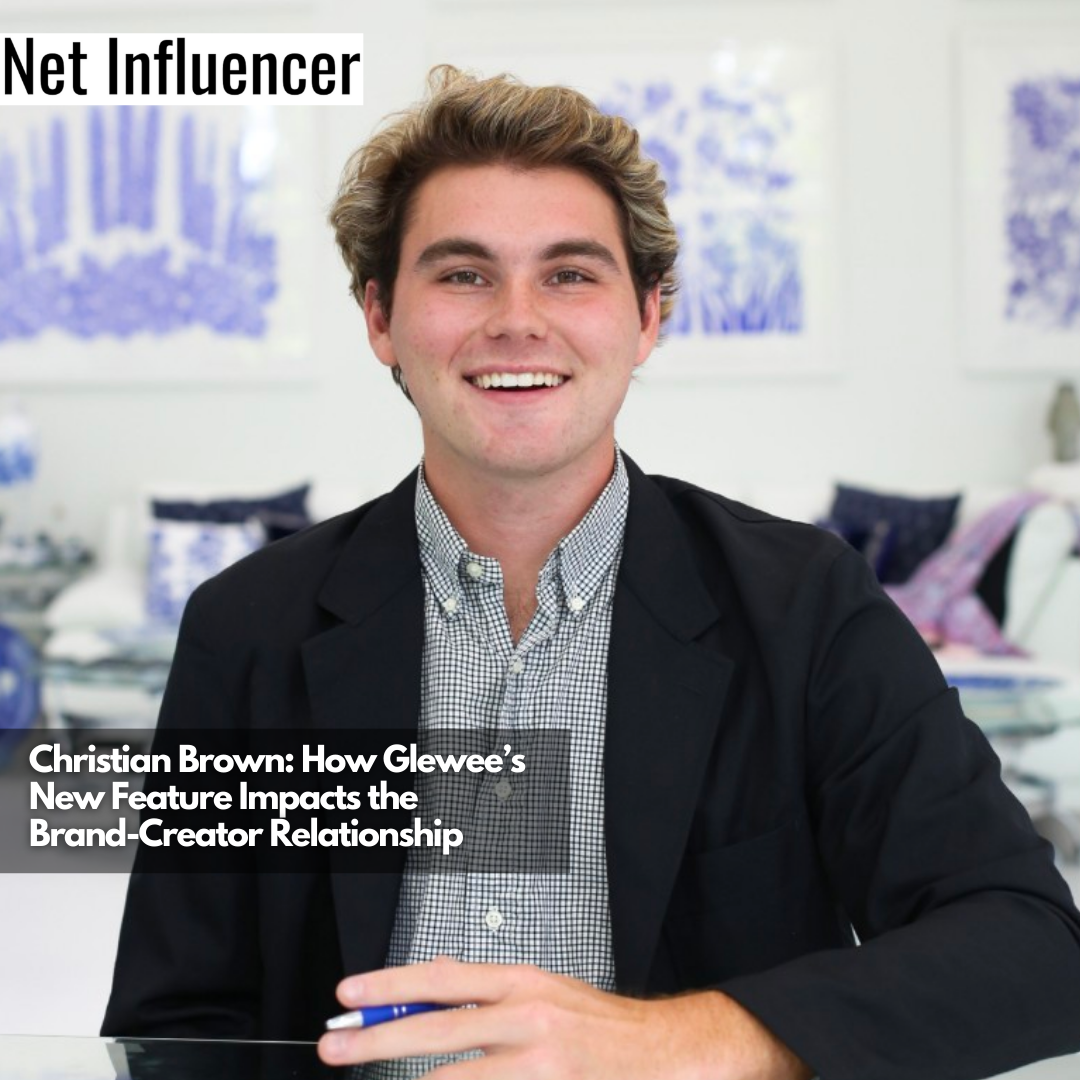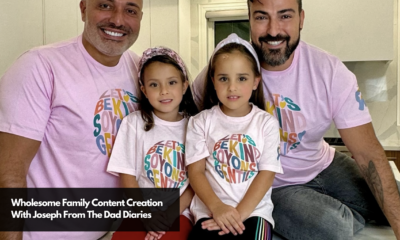Technology
Christian Brown: How Glewee’s New Feature Impacts the Brand-Creator Relationship
Glewee is an app-based platform that brings brands and creators together to create and execute social media campaigns. And just when users thought the Glewee couldn’t get any better, it actually could! In an interview, Christian Brown shares the newest feature of Glewee and how it can empower the app and its users — both brands and creators — more.
Who is Christian Brown?
Christian Brown is the co-founder and Chief Marketing Officer of Glewee, an all-in-one influencer marketing platform that connects brands and creators through paid social media brand deals and collaboration. He was elected for Forbes 30 Under 30: Marketing and Advertising 2023 due to his contribution to creating, scaling, and growing Glewee.

Glewee’s Newest Feature
As user-generated content, or UGC, continues to revamp and redesign the digital ads industry, Glewee wanted creators to have more control over creating user-generated content for brands.
Christian says, “Whereas now, what we’ve done is we’ve gone out, and we’ve allowed creators to set their own rates for UGC. We’ve created a portion of our marketplace and campaign creation process that allows brands to say that they want the creators to just make UGC.”
User-generated content differs from traditional posts because when brands get that UGC from creators, they own that in perpetuity. Charlie describes to us how this new feature works:
“The brand can come in, work with as many creators as they want through Glewee, and send creators their products or give them information on their services. Those creators can now charge for their preset rates or the rates that the brand sets when launching a campaign. Creators can engage in these types of posts, and they’re just creating the content.”
“They’re submitting it for approval, and once it’s approved, the post doesn’t have to go live on the creator’s social. The brand owns that [content], and they can do whatever they want with that. They can share it in their digital ads, across their social pages, and on their website. They can share it with their fans, community, customers, and more,” Charlie adds.

How User-Generated Content Impacts Brand Awareness and Driving Sales Into Today’s Social Media-Driven Economy
Price has contributed to the popularity of user-generated content in brand awareness and driving sales. Christian explains, “People and brands, whether it’s a new or existing brand in the industry, are looking at the idea of price. They’re wondering why they would work with a firm that will make them a commercial, with someone that will give them a super bowl spot, or with a billboard company to do out-of-home advertising when they can create content that’s social-ready, to begin with.”
For brands trying to reach the Gen Z audience, UGC has become more important because its real content created by real people. Integrating content created by real people and actual consumers into their digital marketing and social mix enables brands to relate to their end customers on a deeper level.
One example is Prime Energy, a sports and energy drink company Logan Paul and KSI created. The brand aired an ad in the first quarter of this year’s Super Bowl, and it was entirely created with UGC.
Christian shares, “Instead of spending hundreds or thousands of dollars to create the Super Bowl spot on top of the $7 million cost to run it, they just took content that themselves, their audience, their loyal fans, and their customers created. And they built that into their advertising.”
User-generated content also has become more important than ever because of how end consumers spend their time consuming ads. There has been a massive shift in where and how consumers view ads. Today, people are less likely to be in the metropolis and bustling cities looking around at train ads; they’re spending more and more time on social media.

And when people spend time on social media, their awareness of ads has become more advanced and smarter. With this in mind, brands — whether they’re operating as a B2B, selling direct to consumers, or are in the ecommerce space — should create digital ads that will stop people from scrolling.
Christian believes this goal is easily achieved by using real creators — like the audience — to make real ads. The popularity of UGC and how brands can utilize it for their own digital marketing campaign has grown exponentially in the past year.
How Glewee Can Replace Traditional Advertising With More Authentic Content
Glewee is built and designed exactly to replace traditional ads with more authentic content. To execute that, Charlie shares, “We look at it in a speed, efficient, and cost perspective. With speed, brands come to Glewee, and they can launch a campaign. After just a few minutes, creators will actually apply and opt into that campaign. And for a UGC campaign, we’re seeing creators apply within just three minutes alone.”
In Glewee, brands can set parameters in their campaigns, which expedites the process of selecting the right creator. For example, brands can mention in their campaign that they’re looking for creators in a specific gender, niche, or follower count. Creators can then apply in real time and provide samples that match the campaign’s parameters.
For efficiency, Glewee takes pride in having more than 10,000 pre-vetted creators who excel in UGC creation or creating posts for the traditional influencer. Christian adds, “When you come into Glewee, you’re working not only with us as a platform but with thousands and thousands of industry-leading creators doing this full-time as their jobs.”
When it comes to the price, Glewee enables brands to have and use content in real-time quickly for a very cheap price. This approach is more cost-effective than going out and hiring firms that take several months to onboard and create content for brands. Charlie says, “The minimum price to get UGC on our platform is $100 per creator. Those creators can make videos, images, or different types of UGC.”
Types of Content Brands Order From Creators and How Glewee Selects Creators for Campaigns
All the creators in Glewee’s ecosystem go through a pre-vetting process. When creators download and apply for Glewee, a human team looks at every applicant and assesses their engagement rate. For micro creators, that’s a 2.5% engagement rate; for creators with millions of followers, the engagement rate threshold drops to 1%.

Christian shares that Glewee doesn’t rely on technology or AI to complete this process. And will continue to implement the same approach regardless of the number of applicants they receive yearly — Glewee had over 45,000 applicants last year and got it down to 10,000!
To filter applicants, Glewee also checks the total follower count of the creators and the average likes and comments they get per post. Beyond the numbers, Glewee looks at the professionalism of the creators, their brand deal experiences, and the general community that follows them.
Christian adds, “We are delivering our brands the pre-vetted community of creators who want to work with them, who know how to create content, and are going to make the best content for the best price for the brand.”
How Glewee Guarantees the Quality and Authenticity of Content Produced by Its Creators
Glewee allows brands to proof content to check its quality and authenticity. Christian gives us a rundown on how this system works:
“In the Glewee system, a brand launches a campaign and can work with a large variety of creators in our marketplace. In the process, the creator accepts the deal, and the brand and creator sign in. They understand the deliverables, the exchange being the monetary trade-off, and the deadlines.”
“Once the creator creates the content, they submit it for approval to the brand. And it’s up to the brand to look at the brief they’ve set and the qualifications and then approve the content in our platform. When the content is approved, the content goes into the brand’s Content Asset Library, where they can filter and put the content into different folders. They can download, export, and share that content across social [media],” Christian adds.
But brands can only do all of these once they approve the content. Unapproved content or content that requires revision doesn’t go or sit in the brand’s Content Asset Library.
Additionally, Glewee monitors to ensure that brands are happy with the content they get from the creators. The platform offers feedback and review sessions between the brand and the creator. This way, the brand can provide feedback on how a creator should revise the content or if the creator needs to deliver any additional feedback.
Charlie says, “And that’s really what we’re trying to do here: harness and cultivate relationships between brands and creators. So it’s symbiotic and beneficial for both parties in the most way possible.”
Glewee’s Approach to Influencer Marketing and Why It’s Different
“Glewee, at its core, is for creators by creators and for marketers by marketers. And so, with that, we look at the creator landscape and the influencer marketing landscape, and we identify where it is. Creators have an immense amount of pain points they’re trying to solve, whether it’s growing their following, being in a community of other creators, or finding new brand deals to work with. And when finding new brands, how will they do that in an easy and simplified process?”
Glewee was designed to mitigate or solve common issues faced by creators. Glewee’s iOS, Android, and web apps allow creators to do all of those things all under one roof and within one community, one platform, and one piece of technology.
For the brands, those who are starting don’t have the funds to spend thousands of dollars per month just to go into the database of influencer marketing platforms. Without this access, brands can’t scrape emails, find creators, and do outreach.
This is the common pain point of brands, which Glewee aims to solve. Christian shares, “What we’ve done is we’ve gone in, and we’ve made it easy and accessible [for brands] to connect with creators in real-time, in minutes, in a very cost-effective way.”
Glewee also delivers immense value to brands — whether it’s about data reporting, communication, contracts, and even holding content. Generally, Glewee aims to create a one-stop shop for every social media and e-commerce brand manager.
How Brands and Creators Can Join Glewee
To join Glewee, creators can go to the Google App Store or Apple iOS store and download Glewee. On the app, they need to choose “Apply Creators” and create an account. Glewee’s team will check the creator’s engagement rate, follower count, and others. Once submitted to the platform, creators can set up their portfolios.
Creators can customize their portfolios by setting their rates and authenticating their accounts. From there, they can start scrolling through the platform’s feed of active campaigns and reach out to brands directly in the app.
The process brands must follow to join Glewee is different from the creators. Glewee gives brands the ability to talk to their team of influencer marketing experts to see how the platform fits them. After, brands can apply through app.glewee.io or Glewee’s website. Glewee’s team will reach out to brands after they apply online.
Brands can also book a demo with representatives from Glewee to learn how the platform works and determine which plan best fits the brand.





















